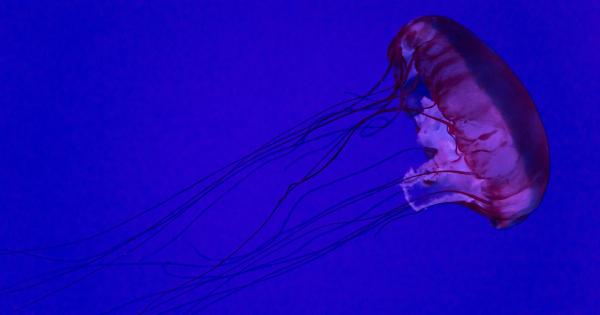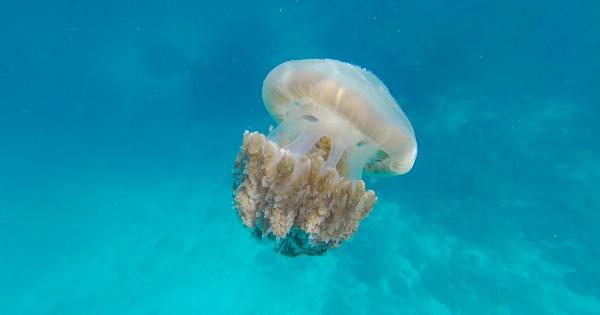Having a dog as a pet brings joy and fulfillment to many people’s lives. However, part of being a responsible pet owner is knowing how to handle various situations that may arise, including emergencies.
One such situation is when your dog gets stung by a purple jellyfish. Jellyfish stings can be painful and potentially dangerous, so it’s important to know how to promptly and effectively treat your furry friend to ensure their well-being.
In this article, we will guide you through the steps to take when your dog encounters a purple jellyfish sting.
1. Assess the Situation
The first step is to assess the situation. Ensure your dog is out of harm’s way, away from the jellyfish and any other potential dangers. Approach your dog carefully, reassuring them in a calm and confident manner.
Avoid getting stung yourself by wearing protective gloves or using a towel or any other barrier between your skin and the jellyfish.
2. Remove Visible Tentacles
Look for any visible tentacles on your dog’s skin. Avoid touching them directly with your bare hands and use a tool like tweezers or a credit card to gently scrape them off.
Be cautious not to rub or scrape too hard, as this can cause the release of more venom. If tentacles are stuck in your dog’s fur, consider carefully trimming the hair around the area to prevent further contact.
3. Rinse with Seawater
After removing visible tentacles, the next step is to rinse the affected area with seawater. Seawater helps to deactivate any remaining stinging cells and wash away any residual venom.
Using a bottle or cup, pour the seawater over the stung area, ensuring that you avoid contact with your dog’s eyes, nose, and mouth.
4. Vinegar Solution
If you don’t have access to seawater, you can create a vinegar solution to rinse the sting. Mix equal parts of vinegar and water and apply it to the affected area with a cloth or sponge. Vinegar helps neutralize the venom and relieve pain.
However, keep in mind that certain jellyfish stings, including those from Man o’ War jellyfish, may not respond well to vinegar. If you suspect your dog has been stung by a Man o’ War, seek immediate veterinary attention.
5. Hot or Cold Compress
After rinsing the sting, you can apply a hot or cold compress to the affected area to help alleviate pain and reduce swelling. Wrap a hot water bottle or a cold pack in a towel and gently place it on the wound.
Avoid applying excessive pressure, and if your dog shows signs of discomfort, discontinue the compress and seek veterinary advice.
6. Monitor for Systemic Symptoms
Observe your dog for any signs of systemic symptoms, which may include difficulty breathing, weakness, vomiting, or seizures.
If your dog experiences any of these symptoms, it is crucial to seek immediate veterinary attention, as the venom could be affecting other parts of the body. Keep a close eye on your dog’s behavior and note any changes or abnormalities.
7. Over-the-Counter Medications
You may consider giving your dog over-the-counter medications to manage pain and inflammation. However, it is essential to consult your veterinarian before administering any medication, as some human medications can be toxic to dogs.
Additionally, your vet can recommend specific dosages based on your dog’s size and condition.
8. Prevent Licking and Scratching
It’s natural for dogs to want to lick or scratch at a wound, but it’s important to prevent them from doing so. Licking or scratching could further irritate the sting and introduce bacteria, leading to infection.
Consider using a cone collar or a medicated ointment specifically designed to discourage licking and scratching. Alternatively, distract your dog with toys, treats, or activities to divert their attention away from the wound.
9. Encourage Rest and Hydration
While your dog is recovering from a jellyfish sting, it’s crucial to allow them to rest and encourage hydration. Offer clean, fresh water regularly to prevent dehydration.
Avoid strenuous activities or long walks, as rest allows the body to heal more efficiently. Provide a comfortable and quiet space for your dog to relax until they fully recover.
10. Follow Up with a Veterinarian
Even if your dog’s condition appears to be improving, it is still advisable to follow up with a veterinarian.
They can ensure that there are no underlying complications, assess the progress of your dog’s recovery, and provide any necessary additional treatment or medication.
Remember, every situation is unique, and the severity of a purple jellyfish sting can vary.
While this article provides general guidance, it is essential to prioritize your dog’s well-being and seek professional veterinary advice if you have any concerns or if your dog’s condition worsens.





























